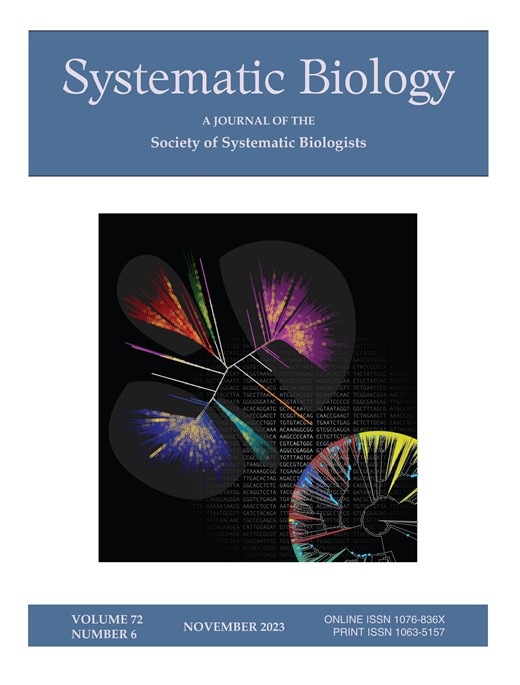但是,时钟滴答作响:一个实证案例研究强调了放松时钟模型在全证据年代测定中的卓越地位
IF 5.7
1区 生物学
Q1 EVOLUTIONARY BIOLOGY
引用次数: 0
摘要
系统发育时钟模型将推断的进化变化量(从基因型或表型计算)转化为经过时间的估计,提供了一种时间尺度系统发育树的机制。松弛时钟模型是贝叶斯测年法的主要组成部分之一,它能适应不同分支间进化速率的变化,但其对全证据系统发育的影响尚未得到彻底探索。在这里,我们结合形态学、分子(转录组学和桑格测序)和地层学数据集,研究了所有主要的棘皮类动物谱系(海胆、心海胆、沙美元)。然后,我们在化石出生-死亡先验下进行了全证据日期推断,改变了两个分析条件:自相关和不相关放松时钟之间的选择,这强制(或不强制)进化速率遗传;以及恢复化石终端作为直系祖先的能力。我们的结果突出了以前未被注意到的树和时钟模型之间的相互作用,实现自相关时钟的分析无法恢复任何直接祖先。然而,即使在有利于化石终端作为祖先放置的条件下,我们发现这种类型的关系可以被容纳,而不会对拓扑结构或节点年龄产生任何影响。另一方面,树木拓扑结构、化石位置、分化时间和下游宏观进化推断(例如,祖先状态重建)都受到所实现的放松时钟类型的强烈影响。在分子速率变化普遍存在且形态信号相对缺乏信息的区域,化石尖端似乎在告知分化时间方面几乎没有作用,而是被动地根据分子数据施加给周围节点的年龄在进化枝上进进出出。我们的研究结果强调了总证据日期分析的系统发育和宏观进化结论在多大程度上取决于松弛时钟模型的选择,强调了需要仔细的方法验证或彻底的敏感性评估。我们的工作将继续阐明棘刺类动物的生命之树,支持Apatopygoida目的建立,包括三个现存物种,最后与其他现存的谱系在侏罗纪-白垩纪边界时期共享一个共同的祖先。此外,它们还说明了灭绝枝的系统发育位置如何依赖于分子数据的建模,证明了化石记录在多大程度上服从于系统基因组学。本文章由计算机程序翻译,如有差异,请以英文原文为准。
But the Clock, Tick-Tock: An Empirical Case Study Highlights the Preeminence of Relaxed Clock Models in Total-Evidence Dating
Phylogenetic clock models translate inferred amounts of evolutionary change (calculated from either genotypes or phenotypes) into estimates of elapsed time, providing a mechanism for time scaling phylogenetic trees. Relaxed-clock models, which accommodate variation in evolutionary rates across branches, are one of the main components of Bayesian dating, yet their consequences for total-evidence phylogenetics have not been thoroughly explored. Here, we combine morphological, molecular (both transcriptomic and Sanger-sequenced), and stratigraphic datasets for all major lineages of echinoids (sea urchins, heart urchins, sand dollars). We then perform total-evidence dated inference under the fossilized birth-death prior, varying two analytical conditions: the choice between autocorrelated and uncorrelated relaxed clocks, which enforce (or not) evolutionary rate inheritance; and the ability to recover fossil terminals as direct ancestors. Our results highlight a previously unnoticed interaction between tree and clock models, with analyses implementing an autocorrelated clock failing to recover any direct ancestors. Nonetheless, even under conditions conducive to the placement of fossil terminals as ancestors, we find this type of relationship to be accommodated without any impact on either topology or node ages. On the other hand, tree topology, fossil placement, divergence times, and downstream macroevolutionary inferences (e.g., ancestral state reconstructions) were all strongly affected by the type of relaxed clock implemented. In regions of the tree where molecular rate variation is pervasive and morphological signal relatively uninformative, fossil tips seem to play little to no role in informing divergence times, and instead passively move in and out of clades depending on the ages imposed upon surrounding nodes by molecular data. Our results highlight the extent to which the phylogenetic and macroevolutionary conclusions of total-evidence dated analyses are contingent on the choice of relaxed-clock model, highlighting the need for either careful methodological validation or a thorough assessment of sensitivity. Our efforts continue to illuminate the echinoid tree of life, supporting the erection of the order Apatopygoida to include three living species last sharing a common ancestor with other extant lineages around the time of the Jurassic-Cretaceous boundary. Furthermore, they also illustrate how the phylogenetic placement of extinct clades hinges upon the modelling of molecular data, evidencing the extent to which the fossil record remains subservient to phylogenomics.
求助全文
通过发布文献求助,成功后即可免费获取论文全文。
去求助
来源期刊

Systematic Biology
生物-进化生物学
CiteScore
13.00
自引率
7.70%
发文量
70
审稿时长
6-12 weeks
期刊介绍:
Systematic Biology is the bimonthly journal of the Society of Systematic Biologists. Papers for the journal are original contributions to the theory, principles, and methods of systematics as well as phylogeny, evolution, morphology, biogeography, paleontology, genetics, and the classification of all living things. A Points of View section offers a forum for discussion, while book reviews and announcements of general interest are also featured.
 求助内容:
求助内容: 应助结果提醒方式:
应助结果提醒方式:


